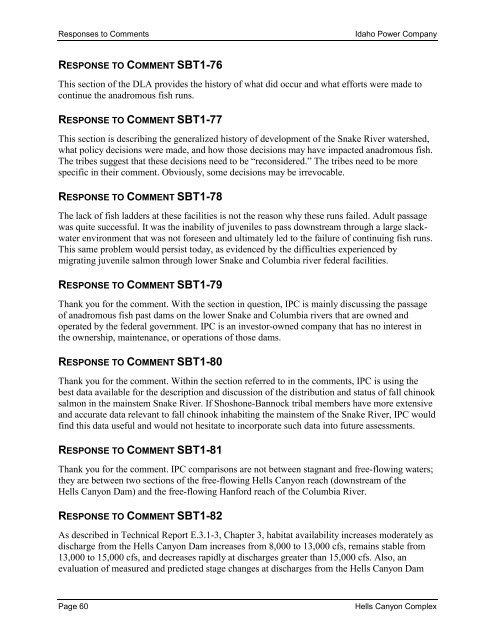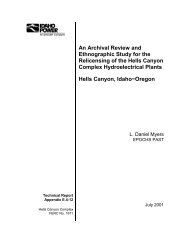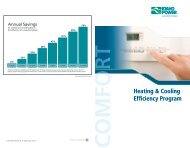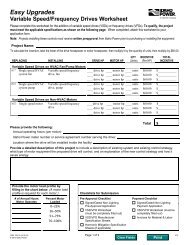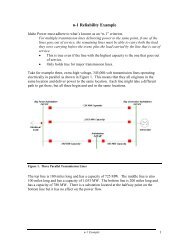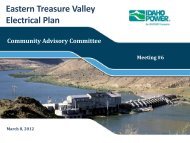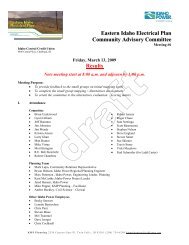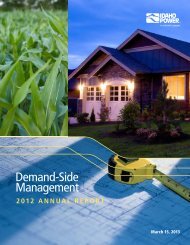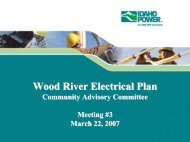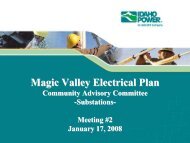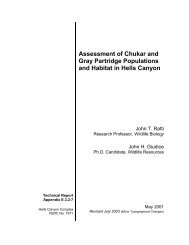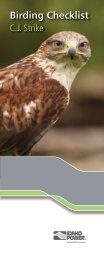Shoshone-Bannock Tribes - Idaho Power
Shoshone-Bannock Tribes - Idaho Power
Shoshone-Bannock Tribes - Idaho Power
You also want an ePaper? Increase the reach of your titles
YUMPU automatically turns print PDFs into web optimized ePapers that Google loves.
Responses to Comments<strong>Idaho</strong> <strong>Power</strong> CompanyRESPONSE TO COMMENT SBT1-76This section of the DLA provides the history of what did occur and what efforts were made tocontinue the anadromous fish runs.RESPONSE TO COMMENT SBT1-77This section is describing the generalized history of development of the Snake River watershed,what policy decisions were made, and how those decisions may have impacted anadromous fish.The tribes suggest that these decisions need to be “reconsidered.” The tribes need to be morespecific in their comment. Obviously, some decisions may be irrevocable.RESPONSE TO COMMENT SBT1-78The lack of fish ladders at these facilities is not the reason why these runs failed. Adult passagewas quite successful. It was the inability of juveniles to pass downstream through a large slackwaterenvironment that was not foreseen and ultimately led to the failure of continuing fish runs.This same problem would persist today, as evidenced by the difficulties experienced bymigrating juvenile salmon through lower Snake and Columbia river federal facilities.RESPONSE TO COMMENT SBT1-79Thank you for the comment. With the section in question, IPC is mainly discussing the passageof anadromous fish past dams on the lower Snake and Columbia rivers that are owned andoperated by the federal government. IPC is an investor-owned company that has no interest inthe ownership, maintenance, or operations of those dams.RESPONSE TO COMMENT SBT1-80Thank you for the comment. Within the section referred to in the comments, IPC is using thebest data available for the description and discussion of the distribution and status of fall chinooksalmon in the mainstem Snake River. If <strong>Shoshone</strong>-<strong>Bannock</strong> tribal members have more extensiveand accurate data relevant to fall chinook inhabiting the mainstem of the Snake River, IPC wouldfind this data useful and would not hesitate to incorporate such data into future assessments.RESPONSE TO COMMENT SBT1-81Thank you for the comment. IPC comparisons are not between stagnant and free-flowing waters;they are between two sections of the free-flowing Hells Canyon reach (downstream of theHells Canyon Dam) and the free-flowing Hanford reach of the Columbia River.RESPONSE TO COMMENT SBT1-82As described in Technical Report E.3.1-3, Chapter 3, habitat availability increases moderately asdischarge from the Hells Canyon Dam increases from 8,000 to 13,000 cfs, remains stable from13,000 to 15,000 cfs, and decreases rapidly at discharges greater than 15,000 cfs. Also, anevaluation of measured and predicted stage changes at discharges from the Hells Canyon DamPage 60Hells Canyon Complex


